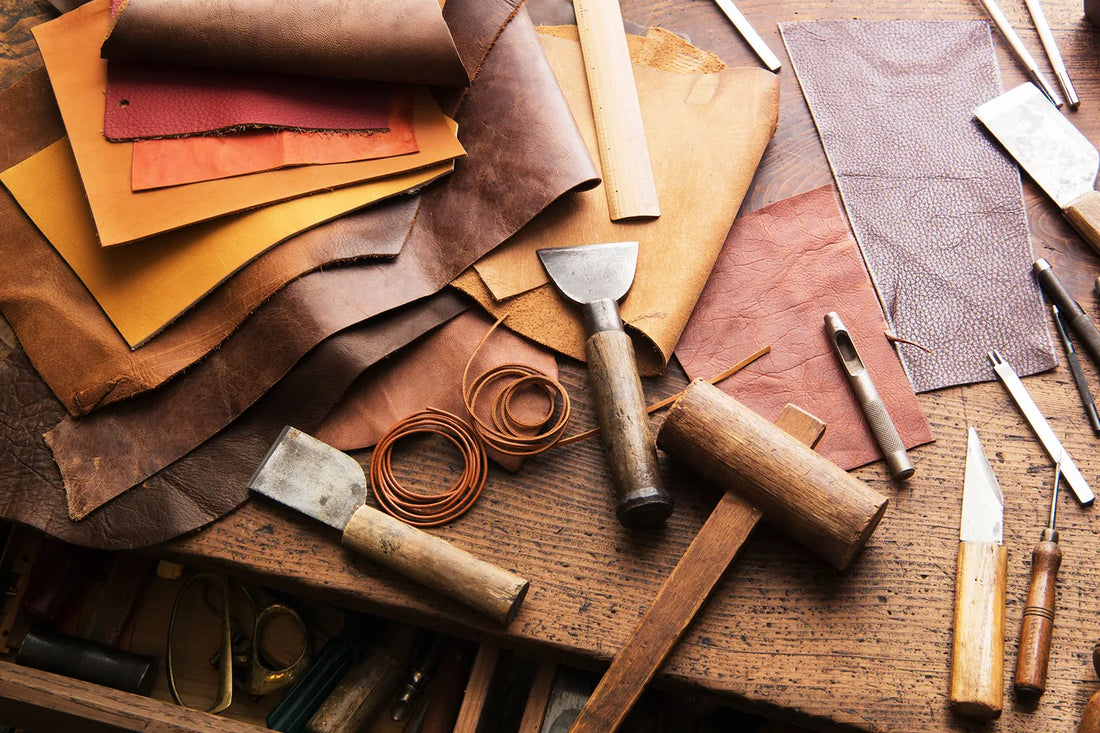
5 min read
Healthy Materials Series: Leather
WLLW considers the health and environmental impacts of the leather we use in our homes.
WORDS Elissa Rose
In the next installment of our ‘Healthy Materials Series', we turn our attention to leather. Leather production is an ancient craft that has been around for over 4,000 years, originating from the need to preserve animal hides for various uses. Today, the vast majority of leather is a byproduct of the meat industry and remains a popular material in the home, known for its natural durability and timeless appeal. It is commonly used in furniture, providing comfort and character and developing a unique patina over time. Leather also features in decorative items like cushions, homewares, detailed inlays and wall panels. So why is it a healthy material?

Working with leather. Photo courtesy of Drobot Dean/Adobe
Health Impact
High-quality, natural leather is breathable, which can help regulate temperature and reduce moisture, thereby minimizing the risk of mold and bacteria. It is also naturally flame retardant, avoiding the need for adding flame resistant chemicals, although it’s worth noting that most commercial upholstery leather is treated with flame retardants anyway. The tanning process can introduce toxins like chromium to the product emitting Volatile Organic Compounds (VOCs). Vegetable-tanned leather is a healthier alternative as it uses natural tannins instead of harmful chemicals, reducing potential health risks. Olive-tanned leather is a nontoxic option. Tanned in an agent made from brewed olive leaves, themselves a byproduct of olive production, it is organic and mineral-free.
Environmental Impact
Due to global overconsumption of meat, supply of animal hides far outstrips demand and the leather industry saves around 7 million tons of waste from landfill every year. When leather reaches the end of its life cycle and is discarded, it decomposes relatively quickly, returning to the soil as organic matter. However, the tanning process can result in the release of toxic chemicals into the environment, contaminating water and soil. Waste management is also a concern, as the industry generates large amounts of solid waste. However, sustainable practices like vegetable tanning and responsible sourcing of hides can mitigate some of these impacts.

Production of leather furniture. Photo courtesy of Photo Lifestyle/Adobe
Pros
- Leather is long-lasting, reducing the need for frequent replacements, which lowers waste and resource consumption.
- Leather is a natural product, free from synthetic chemicals often found in artificial materials, making it a healthier option for indoor air quality.
- When properly treated, leather decomposes faster than synthetic materials, contributing less to landfill waste.
- Leather is easy to clean and less likely to harbor dust mites or allergens, contributing to a healthier home environment.
- Responsibly sourced leather, especially from vegetable-tanned processes, has a smaller environmental footprint compared to chemically processed alternatives.
Cons
- The tanning process, especially with chromium, can release harmful chemicals into the environment and pose health risks.
- High-quality leather, which retains natural variations and coloring while being breathable and developing a natural patina, is often expensive, making it less accessible.
- While leather is biodegradable, certain types treated with chemicals can take longer to break down and may leave harmful residues.
- Particulate matter from heavy metals, generated in the leather industry, has been shown to be carcinogenic and affect the health of factory workers.

Leather dying in a traditional tannery in Morocco. Photo courtesy of Gatsi/Adobe
Typical Finishes, Dyes and Adhesives
Leather is typically dyed using several methods, with some common dyes including aniline, pigment, chrome and vegetable. Aniline dyes can cause headaches, nausea and chronic exposure can lead to more serious health impacts. Pigment dyes are often mixed with binders, which can contain VOCs, contributing to indoor air pollution. Chrome dyes involve chromium salts, which are harmful to the environment and can pose serious health risks if not managed properly, including skin irritation and respiratory issues.
Terms to Avoid
Avoid ‘bycast’ or ‘bi-cast’ leather, which is made with split leather backing and a surface layer of polyurethane, which is then embossed. Polyurethane can off-gas and affect indoor air quality.
Practical Tips
Seek out OEKO-TEX Leather Standard-certified leather to ensure your product is made from high quality material. Examine the grain of any leather item, the natural texture should be visible. The more flawless the product, the higher the likelihood it is not made from genuine leather. The highest quality leather – full grain – comes from the top layer of the hide and is not sanded or buffed to remove natural marks or imperfections. Lower quality leather has a more uniform appearance and is treated to mimic better leather so is often accompanied by a chemical odor.
Plant Based Alternatives
‘Vegan leather’, often marketed as a sustainable alternative to traditional leather, is frequently made from plastic-based materials like vinyl. This creates controversy, as many vegan options still rely heavily on synthetic polymers, which are harmful to the environment. There are leather alternatives formed from natural materials such as cork, rice, coconut waste or natural rubber but these lack durability.. While genuine leather is derived from animal hides and undergoes a tanning process, vegan leather lacks these organic fibrous structures and as such is a misnomer.

The N-BB01 Bookbox produced for August Sandgren by Norm Architects and Karimoku Case Study. Photo courtesy of Norm Architects
 |
 |
Bespoke staircase made using vegetable tanned leather designed by Retrouvius and Bill Amberg Studio. Photo courtesy of Bill Amberg Studio |
Stylist Colin King’s Manhattan Loft. Photo courtesy of Adrian Gaut |

Lemieux Et Cie’s Milo Leather 3-Piece Modular Sofa. Photo courtesy of Lemieux Et Cie
Feature Image: Killy Koon/Adobe
Photography: Drobot Dean/Adobe, Photo Lifestyle/Adobe, Gatsi/Adobe, Norm Architects, Bill Amberg Studio, Adrian Gaut, Lemieux Et Cie


